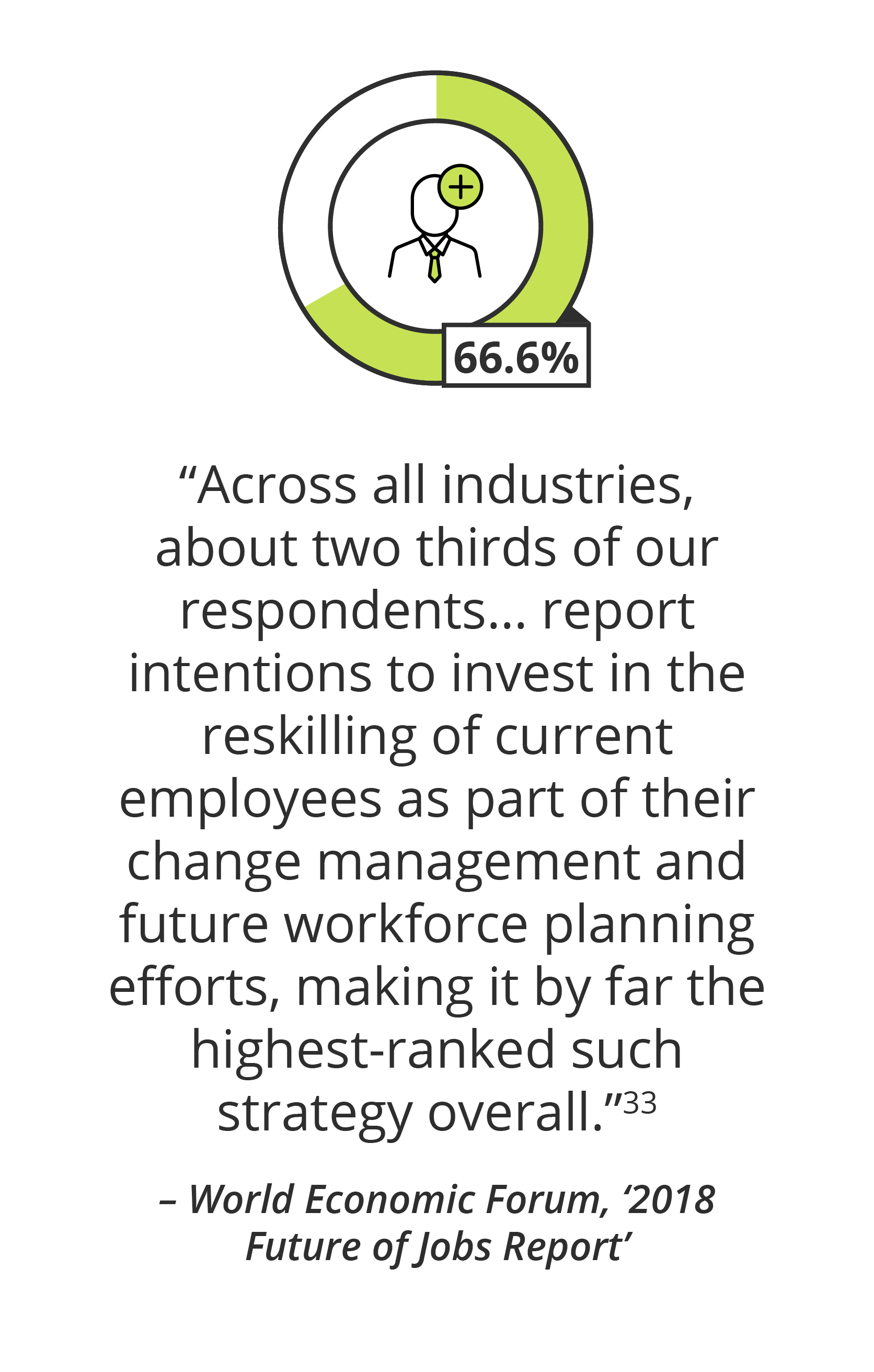Important Skills Development Areas for Employees
Eighty-two per cent of workers are keeping their eyes open for new opportunities.1 One of the reasons why: a lack of opportunities for growth.2 The development needs of an employee aren’t just crucial for fulfilling your company’s skills requirements: development of employees can drive retention and efficiency, too. In fact, ninety-four per cent of employees would stay longer at a company if it invested in their careers.3
Understanding the development needs of an employee starts with recognising that no employee enters your organisation as a perfectly formed staffer. In fact, as your company’s needs evolve due to digital transformation, it’s impossible to consider that any employee entering your business could be entirely prepared for its future needs.4 Here’s the empowering news: sixty-eight per cent of employees prefer to learn at work – giving organisations a great opportunity to drive employee development activities.5
Soft skills development areas
Our increasingly roboticised future has made one thing clear: soft skills development in employees is vital. A robot may be able to do, but a robot is not able to lead.
According to LinkedIn’s ‘2018 Workplace Learning Report’, training soft skills – an employee’s way of thinking and their behaviour – is the number-one priority of talent developers, executives, and people managers.6 Soft skills develop an employee in such a way as to ready them for almost any functional requirement, present or future.7

Hard skills development areas
Hard skills – specialised abilities, often directly relating to an employee’s particular role – are functional by nature and you’re more likely to recruit against these specific requirements. That said, the nature of digital makes it inevitable that you’ll need to continually develop even your most qualified employees in these areas. The best method is through short, sprint-like workshops and courses. Shorter, sharper bursts are more likely to be embraced and retained by employees – and more likely to remain as up to date as possible, content-wise.25

Development areas to future-proof your organisation
‘Digital transformation’ is a buzzword in business for good reason. Mobile internet and cloud technology account for the biggest technological drivers of change in the workplace, closely followed by advances in computing power and big data, new technologies and the Internet of Things (IoT).32


How to identify employee development areas
Approach your needs from two perspectives:
1. What areas does an employee wish to develop in?
This is important for two reasons. Firstly, an employee is on the ground, encountering their own skills deficits and seeing first-hand the innovation for which they need to be upskilled.38 Secondly, if an employee feels invested in, they are more likely to remain in your business.39 Demonstrate your investment in employee growth through feedback, reviews or questionnaires. Other effective tools include:40
- Quarterly one-on-one reviews and assessments
- Internal questionnaires asking employees about development areas
- Making training and development part of employee KPIs
- Mentorship programmes
- Task and time analysis tools like Chase and Slack to track performance and deficit areas
2. What are your business needs?
Compare your business needs with your current employee structure and job descriptions. Use tools such as these (below) to identify your organisation’s future plans and vision, and identify where evolution and development is required:41
- Client or consumer questionnaires and reviews
- Two- to five-year business objectives mapped against current company organograms and employee job descriptions
- Operational capability charts to reveal current competencies compared to required development areas of departments and teams as a whole
It is in almost any organisation’s interest to be invested in the development needs of its employees, not least because this forces a company to continually consider where and how it should innovate and grow. People can be a company’s greatest liability or greatest asset. Driving the right areas of employee development helps a business secure the latter.42
- 1 (2018). ‘Job Seeker Nation Study’. Retrieved from Jobvite.
- 2 (2018). ‘Job Seeker Nation Study’. Retrieved from Jobvite.
- 3 (2018). ‘Workplace Learning Report’. Retrieved from LinkedIn Learning.
- 4 (2018). ‘Futurum 2018 Digital Transformation Index’. Retrieved from Futurum.
- 5 (2018). ‘Workplace Learning ReportTrends’. Retrieved from LinkedIn Learning.
- 6 (2018). ‘Workplace Learning Report’. Retrieved from LinkedIn Learning.
- 7 (Sep, 2018). ‘Why your company should prioritise soft skills’. Retrieved from Forbes.
- 8 (2018). ‘The most in-demand hard and soft skills of 2018’. Retrieved from LinkedIn.
- 9 (2018). ‘Future of Jobs Report’. Retrieved from the World Economic Forum.
- 10 Wigert, B., &Robison, J. (Dec, 2018). ‘Fostering creativity at work: do your managers push or crush innovation?’. Retrieved from Gallup.
- 11 (Dec, 2017). ‘15 ways leaders can promote creativity in the workplace’. Retrieved from Forbes.
- 12 Smith Bedford, G. (Nov, 2013). ‘5 ways to promote creativity in the workplace’. Retrieved from BizJournals.
- 13 (Feb, 2017). ‘TalentSmart Study’. Retrieved from the World Economic Forum.
- 14 (2018). ‘The Sutton Trust Report’. Retrieved from the Education Endowment Foundation.
- 15 Sturt, D. & Nordstrom, T. (Mar, 2018). ‘10 shocking workplace stats you need to know’. Retrieved from Forbes.
- 16 Rogers, K. (Jul, 2018). ‘Do your employees feel respected?’’. Retrieved from Harvard Business Review.
- 17 Shonk, K. (Jul, 2019). ‘Emotional intelligence as a negotiating skill’. Retrieved from Harvard Law School.
- 18 (2018). ‘Future of Jobs Report’. Retrieved from the World Economic Forum.
- 19 (Feb, 2019). ‘Innovation in SA organisations driven by C-level support’. Retrieved from University of Stellenbosch Business School.
- 20 Desikan, A. (April, 2018). ‘Managers spends about 40% of time resolving employee conflicts at work’. Retrieved from The Times of India.
- 21 Sturt, D., &Nordstrom, T. (Mar, 2018). ‘10 shocking workplace stats you need to know’. Retrieved from Forbes.
- 22 Van Rooyen, C. (Nd). ‘Managing conflicts in the workplace’. Retrieved from The South African Labour Guide. Accessed 27 May 2019.
- 23 Schulte, B. (Apr, 2019). ‘Preventing busyness from becoming burnout’. Retrieved from Harvard Business Review.
- 24 Grant, A (Mar, 2019). ‘Productivity isn’t about time management. It’s about attention management’. Retrieved from The New York Times.
- 25 Jenkins, R. (Feb, 2017). ‘How to effectively train millennials in the workplace’. Retrieved from Inccom.
- 26 (Jan, 2019). ‘The most in-demand hard and soft skills of 2019’. Retrieved from LinkedIn.
- 27 (Nd). ‘What is cloud computing?’. Retrieved from Microsoft Azure. Accessed 27 May 2019.
- 28 (2018). ‘Future of Jobs Report’. Retrieved from the World Economic Forum.
- 29 (Nd). ‘Analytical skills: definitions and examples’. Retrieved from Indeed. Accessed 29 May 2019.
- 30 Sarkar, B. (Jul, 2018). ‘5 ways to improve people management skills’. Retrieved from The Economic Times.
- 31 (Nd). ‘The definition of user experience (UX)’. Retrieved from Nielsen Norman Group. Accessed 27 May 2019.
- 32 (2018). ‘Future of Jobs Report’. Retrieved from the World Economic Forum.
- 33 (2018). ‘Future of Jobs Report’. Retrieved from the World Economic Forum.
- 34 Dörner, D., &Funke, J. (Jul, 2017). ‘Complex problem solving; what it is and what it is not’’. Retrieved from the National Center for Biotechnology Information.
- 35 (2018). ‘Future of Jobs Report’. Retrieved from the World Economic Forum.
- 36 (2018). ‘Future of Jobs Report’. Retrieved from the World Economic Forum.
- 37 (2018). ‘Future of Jobs Report’. Retrieved from the World Economic Forum.
- 38 Jones, M. (Aug, 2018). ‘‘How to identify employee training needs’. Retrieved from BreatheHR.
- 39 Misra, P. (Jun, 2018). ‘Investing in your employees is the smartest business decision you can make’. Retrieved from Entrepreneurcom.
- 40 Jones, M. (Aug, 2018). ‘‘How to identify employee training needs’. Retrieved from BreatheHR.
- 41 (Nd). ‘How to conduct a training needs assessment’. Retrieved from SHRM. Accessed 6 November 2019.
- 42 Misra, P. (Jun, 2018). ‘Investing in your employees is the smartest business decision you can make’. Retrieved from Entrepreneurcom.
